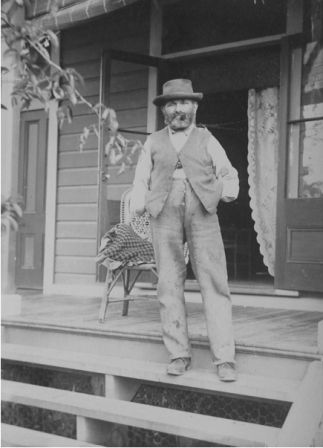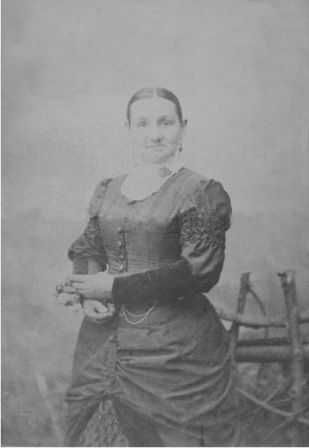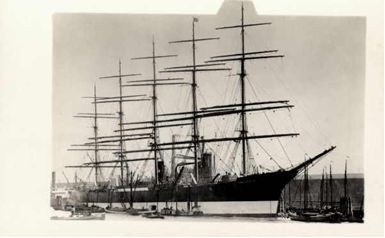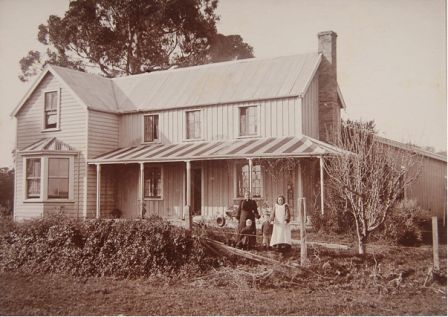The Reays in Brightwater
The rise of George Reay from a modest butcher in the North East of England to a significant property owner in New Zealand is the epitome of a migration success story.
The rise of George Reay, with the support of Elizabeth Ann, from a modest butcher in the North East of England to a significant property owner in New Zealand is the epitome of a migration ‘success story’.
George Reay was born in industrial East Sunderland, England, on 20 February, 1847 to mariner Robert Reay and his wife Jane Burdon,1 the youngest of eight children.
By the time of the 1861 census,2 Robert and Jane had moved to a more attractive address in central Sunderland. George, age 14, a butcher’s boy, was living with his parents and his older brother John and sister Thomasine. In pursuing the profession of butcher, George followed in the footsteps of his older brother William (1836) and several of William’s descendants.3
Elizabeth Ann Coates, George’s future wife, was the seventh child of grocer Richard Coates and his wife, Jane Turnbull, also of Sunderland. George and Elizabeth married on 19 March, 1868.4
George and Elizabeth’s first child, George, was born in 1869.5 Four more children were to follow: Jane Coates (1871),6 Richard Coates (1874),7 Robert Coates (1876), 8 and Alfred Ernest (1879).9
Following the birth of Alfred in 1879, George and Elizabeth made the courageous decision to emigrate to New Zealand. The family departed the UK on board the ‘Potosi’, recorded as arriving in Melbourne on 21 July, 1880 and onward bound to Sydney where they arrived 26 July, 1880. From here it is assumed they left for Nelson, New Zealand arriving about 188110.
George and Elizabeth possibly first settled in Wakefield,11 near Nelson, and then moved to the Hope – Brightwater region. It would have been a sharp contrast to the crowded and polluted streets of Sunderland.
George and Elizabeth had a further two children born in New Zealand: Wilfred George (1885)12 and Lucy Elizabeth Harriet (1891).13
It is reasonable to assume that on arrival, George followed his profession of butcher, first in Wakefield and then in Brightwater14 and Hope.15 However, by 1898 he had turned to farming and was resident at ‘Allington’ in Brightwater.16
‘Allington’ was described as ‘containing 363 acres of magnificent Agricultural and Pastoral Land, well watered and conveniently subdivided. The property, which comprises some of the best of the land in the Waimea, is close to the Railway Station and Sales Yards. Large Dwelling House, Stables, Barns and other Farm Buildings’.17 The dwelling house, a substantial two-storey weatherboard house still standing today, was the home of George and Elizabeth Ann up to their deaths.
A photograph of Elizabeth Ann indicates a woman of considerable strength of character. George is reputed to have been a heavy drinker and lost his right hand after falling from his horse when drunk.18 This accident which ‘necessitated the removal, first of three fingers, and then the whole of the right hand at the wrist’ was reported in the local press.19
George was a well-known figure in the Brightwater region and ‘Allington’ was the site for disc plow trials, conducted by Bisley Bros. & Co.20 The company also cites George as a reference for their mixed rye grass and clover seed.21
Associated with ‘Allington’ was Reay Island in the Wairoa River, where he ran sheep. He also owned a sheep run ‘comprising 4000 Acres of splendid undulating sheep country of limestone formation, well grassed, securely fenced, and conveniently subdivided. New Dwelling House, Wool Shed, Sheep Yards, and other improvements’. 22
After Elizabeth Ann died at ‘Allington’, age 59 on 3 July, 1907,23 George advertised the sale of ‘Allington’, now 143 acres along with 69 acres and 100 acres at Brightwater.24 The sale of ‘Allington’ was further advertised in December 1907, 50 acres in barley with the balance in English grasses. The house is described as a ‘good eight-roomed residence’.25
‘Allington’ 142 acres is again advertised in January, 190826 with a final advertisement on 8 March, 1908. No further advertisements have been found. It is possible that the sheep run, known as ‘Riversdale’ was purchased by the Bisley brothers in 1908.
It would appear that George sold or bequeathed the land associated with ‘Allington’ over the period from 1900 to 1908 ‘piece-meal’. However, he continued to live there until his death at age 68 on 11 March, 1915.27 There is no mention of the property in his Will.
George died a prosperous man leaving legacies totaling £400028, over NZ$500,000 at current value.29
Read more...
The full family history (George REAY and Elizabeth Ann Coates) , covering George Reay Jnr, Jane Coates Reay, Richard Coates Reay, Robert Coates Reay, Alfred Ernest Reay, Wilfred George Reay and Lucy Elizabeth Harriet Reay, can be downloaded as a PDF.
2011. Updated May 2020
Story by: Susan Enns and T. Fred Smith
Sources
- UK National Archives Births Register 1847(2), Vol 24, page 302, Sunderland
- 1861 UK Census RG9/3765, folio 74, p.9
- Sarah Reay and T. Fred Smith A Dynasty of Butchers Journal of the Northumberland and Durham Family History Society, Vol 29, No 4, p.108, 2004
- UK National Archives Marriages Register 1862(2), Vol 10a, p.586, Sunderland
- UK National Archives Births Register 1869(4), Vol 10a, p.525, Sunderland
- UK National Archives Births Register 1871(4), Vol 10a, p.538, Sunderland
- UK National Archives Births Register 1874(1), Vol 10a, p.657, Sunderland
- UK National Archives Births Register 1876(3), Vol 10a, p.614, Sunderland
- UK National Archives Births Register 1879(4), Vol 10a, p.477, Sunderland
- Death Certificate for Elizabeth Ann (1907) records 26 years in New Zealand, that for George (1915) records 33 years in New Zealand
- Nelson Evening Mail, Vol. XVIII, Issue 80, 5 April 1883, George advertises he has disposed of his Wakefield butchery business.
- New Zealand Births Index 1885/12091
- New Zealand Births Index 1891/2629. Birth certificate 9 May 1891
- New Zealand Post Office Directory 1890/91
- New Zealand Electoral Roll 1893, Nelson
- Nelson Evening Mail, Vol. XXXII, Issue 165, 22 July, 1898, p.2
- Nelson Evening Mail, Vol. XXXIV, Issue 297, 17 December, 1900, p.4 Advertisement for the sale of the property.
- Family anecdote
- Colonist, Vol. XLIV, Issue 10089, 24 April 1901, p.3
- Colonist, Vol. XLVII, Issue 11291, 27 March, 1905, p.4
- Nelson Evening Mail, Vol. XXXI, Issue 98, 27 April, 1897, p.4
- Nelson Evening Mail, Vol. XXXIV, Issue 297, 17 December, 1900, p.4 Advertisement for the sale of the property
- Death certificate, New Zealand Deaths Index 1907/5994. Death notice Nelson Evening Mail, Thursday, 4 July, 1907
- Colonist, Vol. XLIX, Issue 12065, 14 October 1907, p.2
- Nelson Evening Mail, Vol. XLII, 10 December 1907, p.4
- Nelson Evening Mail, Vol. XLII, 28 January 1908, p.4
- Death certificate, New Zealand Deaths Index 1915/1605. Death notice Nelson Evening Mail, Friday 12 March, 1907.
- Will, Archives New Zealand, AA00 17072 W5410 1362, Probate Number 1362
- Based on CPI purchasing power New Zealand Reserve Bank,
https://www.rbnz.govt.nz/statistics
Further Sources
Newspapers
- Enns, S. & Smith, F. (2010, March) Lucy E.H. Reay. The Geneaolgist



